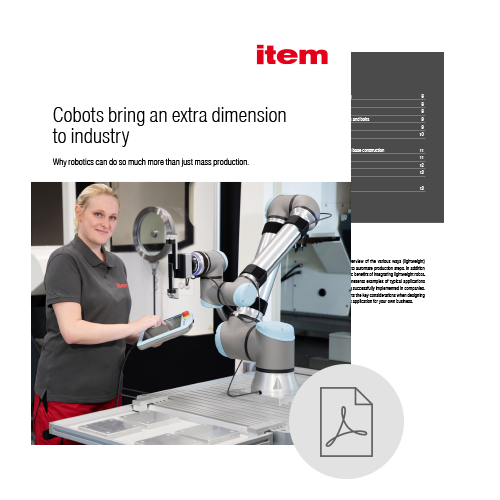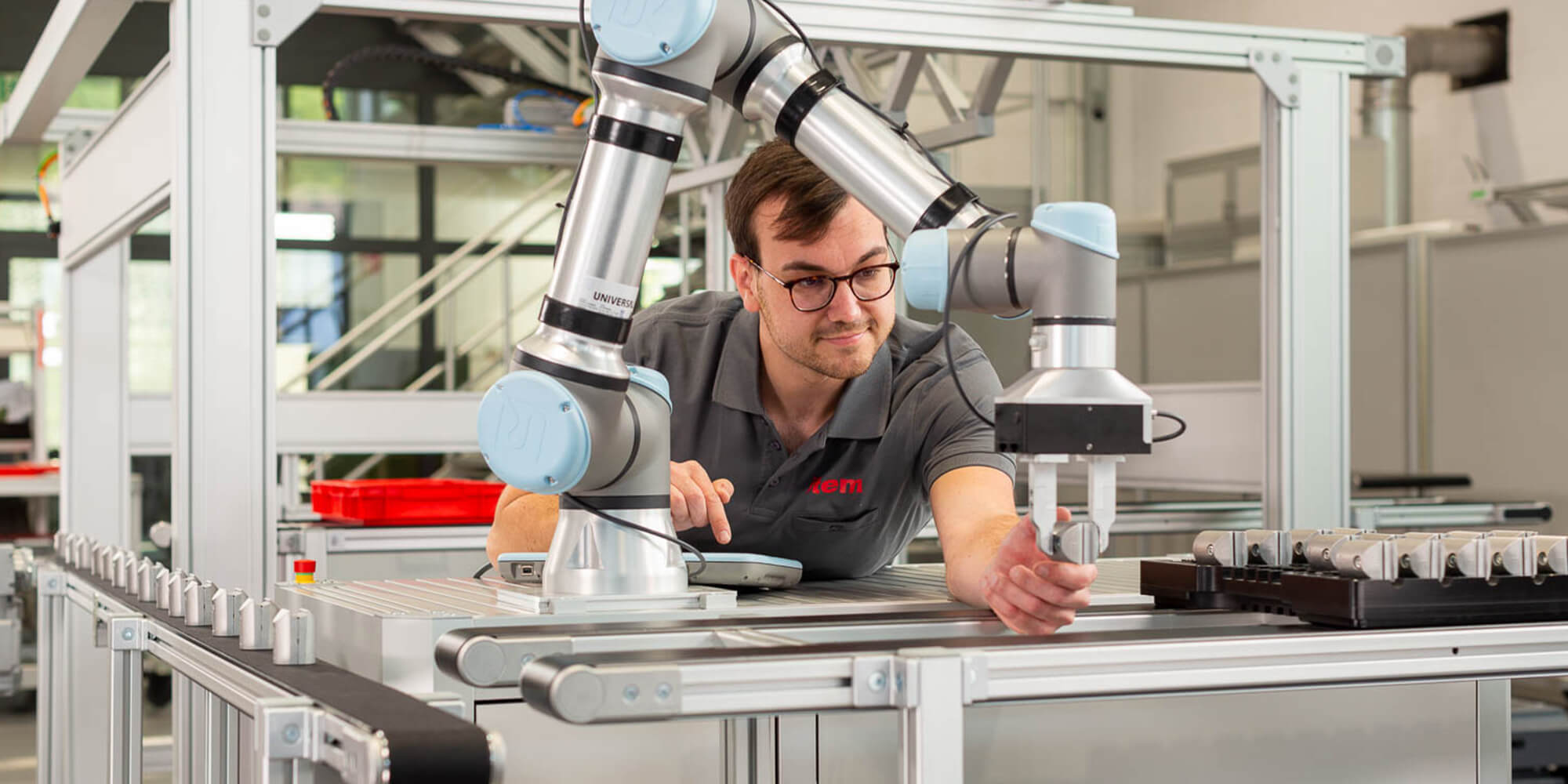Using robots in industry is getting easier all the time, as demonstrated by cobots. We explain the basics and what is important when getting started.
ChatGPT was indisputably the most widely discussed technology trend in 2023. Artificial intelligence (AI), which used to be a niche topic, grabbed the interest of the general public and businesses alike. Nowadays, using AI is no longer the preserve of specialists. You can achieve amazing results without knowing any programming languages. ChatGPT is just part of a wider trend, though. According to the Berlin Social Science Center (WZB), digital assistance systems help people “largely automatically with the tasks they perform in their jobs”. The WZB distinguishes between two types of digital assistance systems – for cognitive tasks (as in the case of ChatGPT) and for manual tasks. Collaborative robots (cobots) are a prime example of the second category.
Cobots have opened up a technology for widespread use. Getting started is now much easier, partly because there is no need for complex programming. Further benefits include easy integration, the ability to swap out tools quickly, a lightweight design and wide-ranging applications. Thanks to these user-friendly credentials, people are increasingly talking about the democratisation of robotics. What exactly is a cobot, though? Where is the best place to start if you are looking to use cobots to automate processes? And what is the best way of integrating cobots into production operations? That is the key difference between a cobot and a chatbot, you see. Cobots are reliant on support. To realise their full potential, they require the kind of robot peripherals that can be created using our item Building Kit System.

An overview of robot applications
Read our white paper to discover even more applications and advantages of robotics in industry – and why it’s a particularly worthwhile investment for SMEs, too.
GO TO THE DOWNLOAD
Cobots (collaborative robots) – definition and benefits in production
Despite a number of differences, the terms “cobot” (or “collaborative robot”) and “lightweight robot” are often used synonymously. In the case of collaborative robot, the name says it all – appropriate sensor technology means it can work collaboratively with people. Resistance sensors in its joints ensure the cobot stops moving as soon as it encounters an obstacle. Further sensor technology and safety fixtures can be added, depending on the specific application and the mode of operation. Nowadays, however, cobot is essentially a synonym for “plug & play” and “easy to use”.
A lightweight robot, on the other hand, is an industrial robot that is smaller, lighter and more agile than a conventional equivalent. In principle, you can use a lightweight robot as a cobot, but it is then important to take appropriate safety precautions. Intuitive software, graphical user guidance and customisable configuration templates are used to program a cobot.
Thanks to its lightweight design, you can attach a cobot to a mobile solution. It can then be used for a variety of processes.
Simply guiding the robot arm to initiate a learning process and entering waypoints is sufficient for some tasks, but not for operations such as sorting and separating bulk goods. This is where AI-based software such as robobrain® comes in. This control platform developed by the Munich-based start-up robominds gives the cobot a brain of sorts that obtains input based on the images from a 2D/3D camera. Since the software provides the cobot with ready-to-use skills, there is no need for it to learn these from scratch. Our blog post about laboratory automation describes how two cobots developed by Universal Robots sort sensitive laboratory samples with the help of AI. Both these cobots are located in a robot cell based on our Line XMS.
One particular advantage of collaborative robots is the ability to quickly swap out tools. You can use specific end effectors that perform different tasks, depending on the application in question. Besides pneumatic and electromechanical grippers, the wide range of options also includes systems for screw fixings, welding and palletising. Depending on the system being used, it is even possible to carry out automated tool/gripper changeovers in a matter of seconds. Thanks to its lightweight design, you can also attach a cobot to a mobile solution. It can then easily be transported to wherever it is needed.
Collaborative robots are the ideal starting point for automation
If you are intending to use a collaborative robot for the first time, it is best to start with a small, manageable pilot project. Understandably, many companies are looking to solve a key challenge straight away. However, this often involves making changes to existing processes. It is therefore better to try things out in a small, affordable project and achieve rapid results. You can then go on to use the knowledge you have gained for the specific purpose of pushing ahead with cobot-based automation in stages. This approach also gives your staff sufficient time to familiarise themselves with their new robot colleagues and discover the full potential of collaborative robots – a process that also involves simple programming of cobots, setting up software and correcting errors. Whether established industrial work processes are changed by rolling out lean production or introducing cobots, getting staff on board is a must if these changes are to be a success. Applications at the start of the production chain such as pick & place tasks and machine loading are ideal for a project of this kind.
With collaborative working becoming less and less important, the focus is now shifting to making the integration, commissioning and utilisation of cobots straightforward.
One example of machine loading is continuously stocking a folding or embossing press with blanks. This is a repetitive task for which skilled workers are often overqualified. If cobots take over this work, these employees can use their expertise for more challenging tasks. It often takes no time at all for a company to implement a robot application of this kind. From these examples of getting started with cobots, you have no doubt surmised that, despite their name, cobots are not necessarily used for human-robot collaboration. In fact, the norm is for there now just to be occasional collaboration between human workers and robots, when feeding in and removing materials. This approach has proved particularly popular for welding tasks and palletising. That is by no means a drawback – quite the opposite, in fact. With no staff in the immediate vicinity, there is no need for the cobot to operate at a limited production speed. With collaborative working (or human-robot collaboration) becoming less and less important, the focus is therefore shifting to making the integration, commissioning and utilisation of cobots straightforward. What’s more, collaborative robots are being enhanced in a way that means the gap between cobots and industrial robots is getting ever smaller. For example, their load-carrying capacities and speed are increasing all the time. Models such as the SWIFTI™ CRB 1100 from ABB and the UR30 from Universal Robots are prime examples.
Using the item Building Kit System to create modular robot peripherals
Following your pilot project, cobots can gradually be integrated into production at various points. Changing requirements mean it is not uncommon for existing robot solutions to be extended and modified. In view of all these factors, a modular design approach is the perfect solution. Robot peripherals have a direct impact on the possible uses of a collaborative robot. Having the freedom to configure peripherals to suit your requirements and being able to adapt them flexibly is therefore a must. Use the modular item Building Kit System to create robot peripherals that are specifically geared to your particular application. Numerous sample solutions can be found in the item Online Shop, including a mobile robot pod with cable grommet and handle, a basic work bench for collaborative applications and a partially enclosed cabin for using cobots.
Convert your item work benches to add robotics. Special Robot Mounting Plates for cobot models from all popular manufacturers are available for this purpose.
Benefit from the advantages typically associated with our aluminium profile technology. All constructions combine a lightweight design with excellent stability. Versatile fastening technology gives you the flexibility to modify and extend existing solutions. For example, you can turn a static base structure into a mobile one by adding castors. Are you already using item work benches? If so, why not convert these to add robotics? Special Robot Mounting Plates for cobot models from all popular manufacturers are available for this purpose:

Collaborative robotics – know-how and products for industrial companies
Regardless of whether your company is already using cobots or you just want to find out a bit more about them, our online information about robotics in industry provides you with expert knowledge and examples of actual applications. All you need to access the online training courses of the item Academy is an item user account. You can register for one here – it is completely free of charge. Find out about cobot-based automation in production and appropriate products right now:
- Online training: “Introduction to robotics”
- Robotics applications with item – overview plus e-paper
- Fastening elements plus sample solutions relating to products for cobots
- Blog post: “Human-robot collaboration – benefits of cobots in industry”
- Blog post: “Areas of application for robots – palletising and machine loading”
- Blog post: “Areas of application for robots – screw fixings and welding”
- Blog post: “Robotics applications – assembly and sorting”
- Blog post: “Advantages of robots in industry”
- Blog post: “Programming robots on a tablet – it couldn’t be easier!”
- Blog post: “Smart robots in the lab – for automated sample handling”
- Blog post: “Flexible robot tables with enhanced design and ergonomics”
- Blog post: “Robot solutions for all kinds of applications”
- Blog post: “Human-robot collaboration – an example for SMEs”
Want all the latest updates on innovative robotics applications? Simply subscribe to the item blog by completing the box at the top right.


